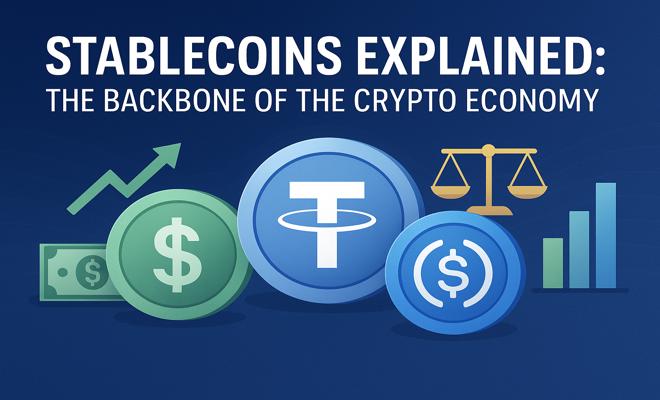
Stablecoins Explained: The Backbone of the Crypto Economy 💵⚖️
💡 In the ever-evolving world of cryptocurrencies, volatility is the norm — except when it comes to stablecoins. These digital assets are designed to offer the best of both worlds: the benefits of blockchain technology and the stability of traditional fiat currencies. But what exactly are stablecoins? And why are they becoming so crucial to the global crypto economy? Let’s dive deep. 🌊
🔍 What Are Stablecoins?
A stablecoin is a type of cryptocurrency that aims to maintain a stable value, typically pegged to a fiat currency like the US Dollar (USD), Euro (EUR), or even gold. Unlike Bitcoin or Ethereum, which fluctuate wildly in price, stablecoins are designed to avoid extreme volatility — making them a reliable medium of exchange and store of value. 💲
📚 Types of Stablecoins
There are several different types of stablecoins, each backed by different mechanisms:
1. Fiat-Collateralized Stablecoins 🏦
These are backed 1:1 by traditional currency reserves. For every stablecoin issued, there's an equivalent amount of fiat held in a bank.
- Examples: Tether (USDT), USD Coin (USDC), TrueUSD (TUSD)
- Pros: High stability, fully backed
- Cons: Requires trust in a centralized issuer
2. Crypto-Collateralized Stablecoins 🧮
These use crypto assets as collateral and are often over-collateralized to account for price volatility.
- Example: DAI (backed by ETH and other crypto)
- Pros: Decentralized, transparent
- Cons: Complex systems, dependent on smart contracts
3. Algorithmic Stablecoins 🤖
These are not backed by any collateral. Instead, they use algorithms and smart contracts to control supply and demand, maintaining price stability.
- Example: Frax (FRAX), Ampleforth (AMPL)
- Pros: Fully decentralized, innovative
- Cons: Risky, often unstable during market shocks
🌐 Use Cases of Stablecoins
Stablecoins have transformed how users interact with the crypto ecosystem. Their most common uses include:
- 🔁 Crypto Trading: A stable base pair for buying and selling volatile assets
- 🌍 Remittances: Fast, low-cost cross-border payments
- 💰 DeFi Protocols: Lending, borrowing, and yield farming platforms
- 🛒 Payments: Accepted by online merchants and service providers
- 📉 Hedging: Temporary refuge during market downturns
🧠 Benefits of Stablecoins
- ✅ Stability: Ideal for users seeking price predictability
- ⚡ Speed: Instant transfers without banking delays
- 🌍 Accessibility: No bank account needed, borderless use
- 💵 Liquidity: Easy to trade and convert
- 💡 Programmability: Useful in smart contracts and DeFi
⚠️ Risks and Concerns
- 🔒 Centralization: Fiat-backed stablecoins depend on trusted third parties
- 📜 Regulation: Subject to increasing government scrutiny
- 💣 Algorithmic Failure: Some algorithmic stablecoins have collapsed (e.g., TerraUSD)
- 🤐 Lack of Transparency: Not all issuers provide regular audits
⚖️ Regulation of Stablecoins
Governments and financial authorities around the world are actively regulating stablecoins. The goal is to ensure consumer protection, prevent money laundering, and avoid financial instability.
- 🇺🇸 USA: Discussions around regulating stablecoin issuers like banks
- 🇪🇺 EU: MiCA framework for digital assets includes stablecoin rules
- 🇸🇬 Singapore: Regulatory sandbox for stablecoin projects
🏛️ Stablecoins vs CBDCs
Stablecoins often get compared to Central Bank Digital Currencies (CBDCs). While both aim to bring fiat to the blockchain, the key differences are:
- 👨💼 Issuer: CBDCs are government-backed; stablecoins are private
- 🔐 Privacy: Stablecoins offer more anonymity
- 🧱 Innovation: Stablecoins integrate with DeFi and Web3 apps
🚀 Future of Stablecoins
Stablecoins are poised to remain a foundational part of the crypto economy. Innovations in collateral design, algorithmic control, and legal frameworks will continue shaping the landscape.
We may also see:
- 📈 Institutional adoption for treasury and payroll systems
- 🏦 Integration into mainstream fintech apps
- ⚖️ Coexistence with CBDCs in hybrid financial systems
🧭 Final Thoughts
Stablecoins serve as a crucial bridge between traditional finance and the decentralized future. They provide the reliability of fiat with the speed and flexibility of blockchain. As crypto adoption grows, understanding stablecoins becomes essential for every user and investor. 💼💡
Stay tuned with BitMedia24 for more deep dives and practical guides into the world of digital assets. 🌐